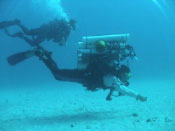Teaching Sciences by Ocean Inquiry
Laboratory Activity: Pressure |
|
Held at the Darling Marine Center in Walpole, ME
Summers 2006 through 2008 |
|
|
|
| |
ANOTHER "SPIN" ON THIS TOPIC
To overcome the drag associated with living in water, the bodies of many aquatic species are elongated. Some marine animals move through water by creating lift with their fins, similar to how airplane wings aid flight. When the shark tilts up a fin, water flow creates greater pressure below the fin than above it, causing upward lift. Tilting a fin down causes greater pressure above the fin than below it, pushing the shark downward. (Contributed by Adam Casey, workshop TA & also based on "Shark Movement") |
|
|
Pressure is one of the most important environmental factors marine organisms must cope with. To get a sense of this, you need not go far: dive to the bottom of a swimming pool to feel increased pressure on your ears. This is the result of a stress - or force per unit area - applied to your body by the fluid around you. The pressure effect is most pronounced on cavities in your body that are filled with compressible gas such as your lungs, sinuses, and ears. Pressure also affects the solubility of gases in fluids (e.g., nitrogen in blood) which is important for understanding diving physiology (e.g., "the bends").
What can pressure tell us about the ocean and the life within it?
When at depth, ocean life is pressed down by the weight of the fluid above it (termed "hydrostatic pressure"). The deeper an organism is, the higher the pressure it experiences. Imagine the pressure that a sperm whale experiences when it dives to depths greater than 1000 meters! At small scales, many marine organisms that feed on small particles (e.g., shellfish, suction feeding fish, sponges) actually take advantage of pressure differences by generating flows that assist in the intake of food (similar to sipping through a straw).
An important - and perhaps less obvious - effect of pressure on our oceans is its impact on water transport. In the ocean (and atmosphere), pressure differences between locations cause fluids such as water (and air) to move. On a non-rotating planet, the movement would be relatively straightforward: from high pressure to low pressure. However, things are more complex on our rotating Earth: the Coriolis force deflects ocean currents (and winds) from their nominally "straight" paths. As a result, large-scale circulation in the ocean (and atmosphere) occurs as circular gyres around regions of high and low pressure.
How might this workshop benefit my students?
The activities we used in this lab allowed students to examine aspects of both static pressure: hydrostatic pressure (as in the case of the pressure exerted by the column or air and water) and dynamic pressure (acceleration or deceleration of flow as a result of changes in pressure, Bernoulli Principle). Full details and explanations of stations are available by clicking here (2.7 MB PDF file).
|






